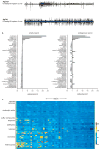Odorant reception in the malaria mosquito Anopheles gambiae
- PMID: 20130575
- PMCID: PMC2833235
- DOI: 10.1038/nature08834
Odorant reception in the malaria mosquito Anopheles gambiae
Abstract
The mosquito Anopheles gambiae is the major vector of malaria in sub-Saharan Africa. It locates its human hosts primarily through olfaction, but little is known about the molecular basis of this process. Here we functionally characterize the Anopheles gambiae odorant receptor (AgOr) repertoire. We identify receptors that respond strongly to components of human odour and that may act in the process of human recognition. Some of these receptors are narrowly tuned, and some salient odorants elicit strong responses from only one or a few receptors, suggesting a central role for specific transmission channels in human host-seeking behaviour. This analysis of the Anopheles gambiae receptors permits a comparison with the corresponding Drosophila melanogaster odorant receptor repertoire. We find that odorants are differentially encoded by the two species in ways consistent with their ecological needs. Our analysis of the Anopheles gambiae repertoire identifies receptors that may be useful targets for controlling the transmission of malaria.
Conflict of interest statement
The authors declare no competing financial interests.
Figures





Comment in
-
Behavioural neurobiology: The treacherous scent of a human.Nature. 2010 Mar 4;464(7285):37-8. doi: 10.1038/464037a. Nature. 2010. PMID: 20203594 No abstract available.
References
-
- World Health Organization. World Malaria Report. 2008.
-
- Takken W. The Role of Olfaction in Host-Seeking of Mosquitos - a Review. Insect Science and Its Application. 1991;12:287–295.
-
- Takken W, Knols BGJ. Odor-mediated behavior of Afrotropical malaria mosquitoes. Annual Review of Entomology. 1999;44:131–157. - PubMed
Publication types
MeSH terms
Substances
Grants and funding
LinkOut - more resources
Full Text Sources
Other Literature Sources
Medical
Molecular Biology Databases

